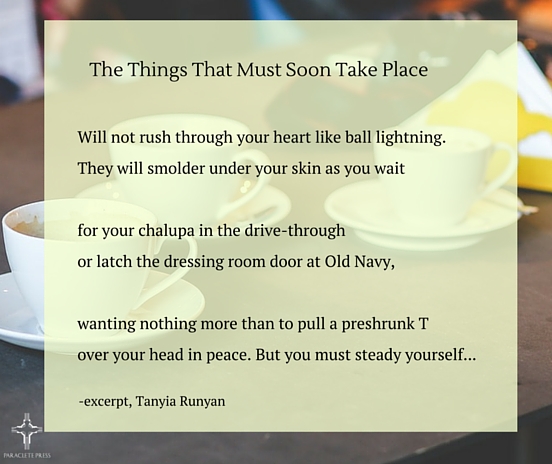By Tania Runyan, author of four poetry collections, including Delicious Air, which was awarded Book of the Year by the Conference on Christianity and Literature.
Can any real art come from the suburbs?
This question popped up on my Facebook feed a few weeks ago. I immediately came to the defense of the writers, musicians, painters, and dancers who create their work on these leafy avenues.
Because if anyone should receive an embossed certificate for living a fully committed suburban life, it’s me.
I grew up in southern California–first in Lakewood, the town D.J. Waldie made famous in Holy Land: A Suburban Memoir, then Rossmoor, one of our nation’s first walled towns. After spending adulthood bouncing around the Chicago area with my husband, we now live in a far-flung burb near the Wisconsin border. Our town adjoins a major amusement park and outlet mall.
Suburbs have changed over the years. They’re more diverse in their populations and often easier to afford than the cities they surround. But they are still the suburbs.
Communities planned by developers lack the heritage and charm of historical cities or rural towns. I know this. I see the Nails/Subway/Fro-yo/Walgreens strip malls flanking the boulevards overrun with Disney-stickered minivans. I don’t pretend that the mass-market watercolor prints in my kid’s orthodontist office are on par with the paintings hanging in the Art Institute of Chicago.
But still, I take issue with the assumption that good art can’t come from these places. Suburbs have their flaws, most notably their legacies of conformity and exclusion. “White flight” is an all-too-common dark spot on many families’ timelines.
But these legacies on their own don’t remove the potential for creative expression. For a few generations, now, the suburbs haven’t symbolized escape. They’ve meant home, as real as a city storefront or rural dirt road.
Where there is no art, we’ve come to understand, there is no spirit. And even up in these dull parts the Spirit whips through me, batters me like a picket fence in a storm.
In my forthcoming poetry collection What Will Soon Take Place, I journey through the book of Revelation as a 40-something suburban mother of three. If I am to believe that God speaks through scripture through all time, I must trust that even someone like me, far removed from wild-eyed John in the cave on Patmos two thousand years ago, has a way to respond.
What is real to me? Fast Food. Chain clothing stores. Dogs roaming the sidewalks. In these mundane patterns of suburbia, the voice of God still speaks.
The Things That Must Soon Take Place
Will not rush through your heart like ball lightning.
They will smolder under your skin as you wait
for your chalupa in the drive-through
or latch the dressing room door at Old Navy,
wanting nothing more than to pull a preshrunk T
over your head in peace. But you must steady yourself
on the purse hook, nauseated by the spirit
burying inside you like a tick. Soon you will see
seraphim wings in the price tags,
hear trumpets in the vents. You will awaken
to asphalt poking your soles like swords of fire,
to the grocery bagger’s billowing breath.
These things will not horse through you
but nudge you like a dog in the street,
a matted earthbound begging for your touch,
wet nose you’ll never wipe off.

Tania Runyan, author of four poetry collections, including Delicious Air, which was awarded Book of the Year by the Conference on Christianity and Literature. Her forthcoming volume will appear with Paraclete Press, What Will Soon Take Place, an imaginative exploration of the final biblical book, The Revelation to John. Her poems have appeared in many publications, including Poetry, Image, Harvard Divinity Bulletin, The Christian Century, Atlanta Review, Indiana Review, Willow Springs, Nimrod, and the anthology In a Fine Frenzy: Poets Respond to Shakespeare. She lives and writes in suburban Chicago.